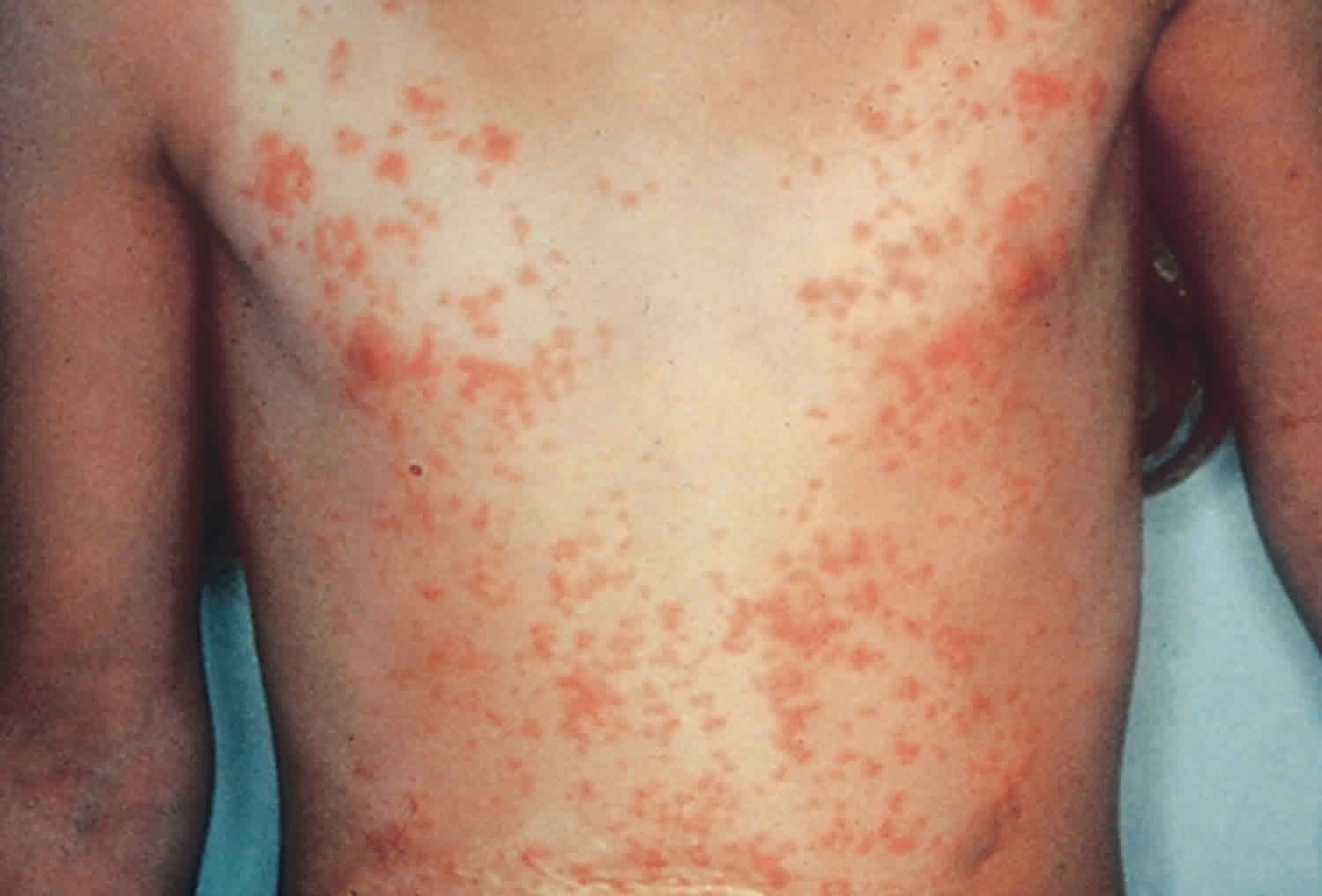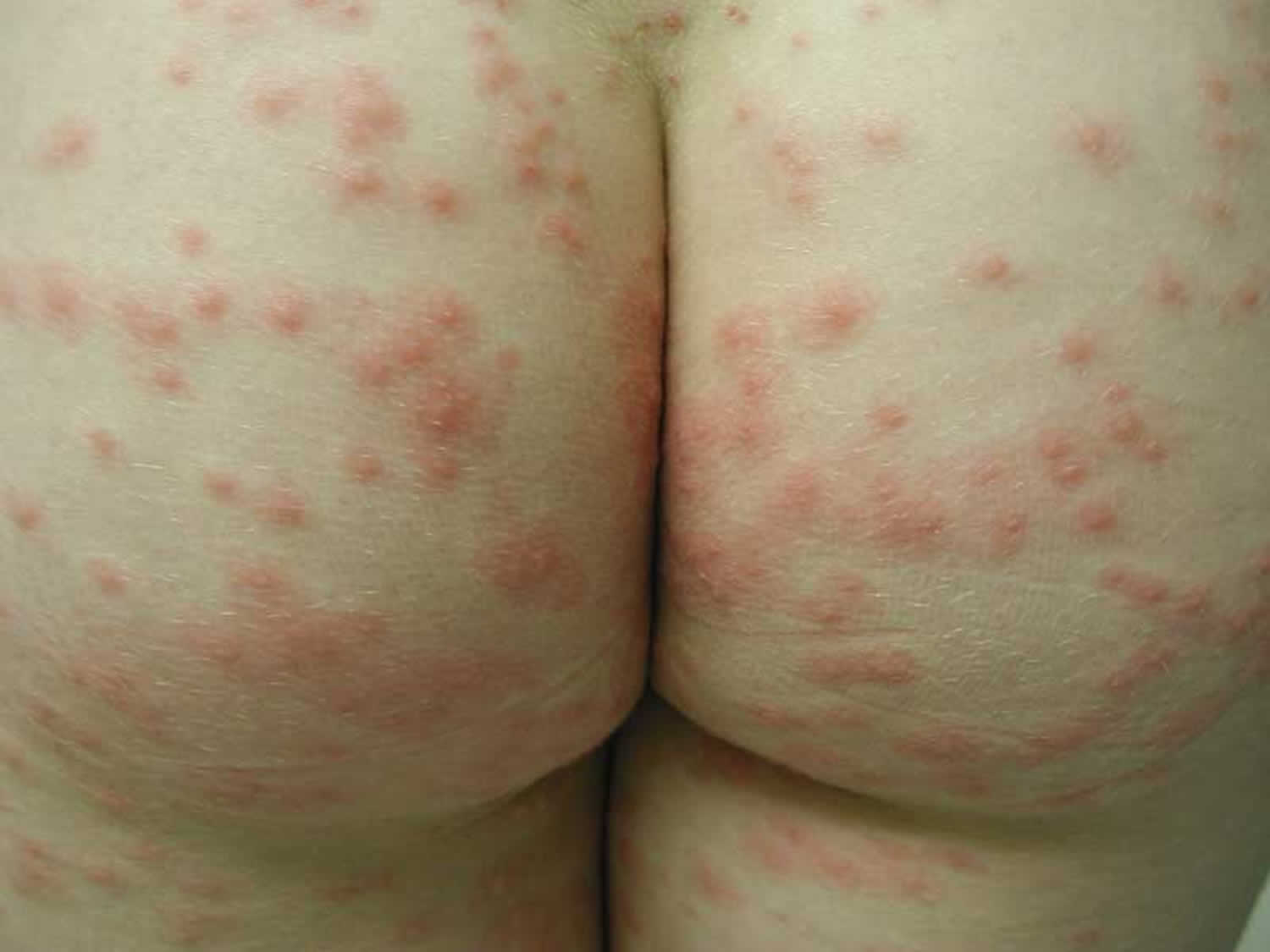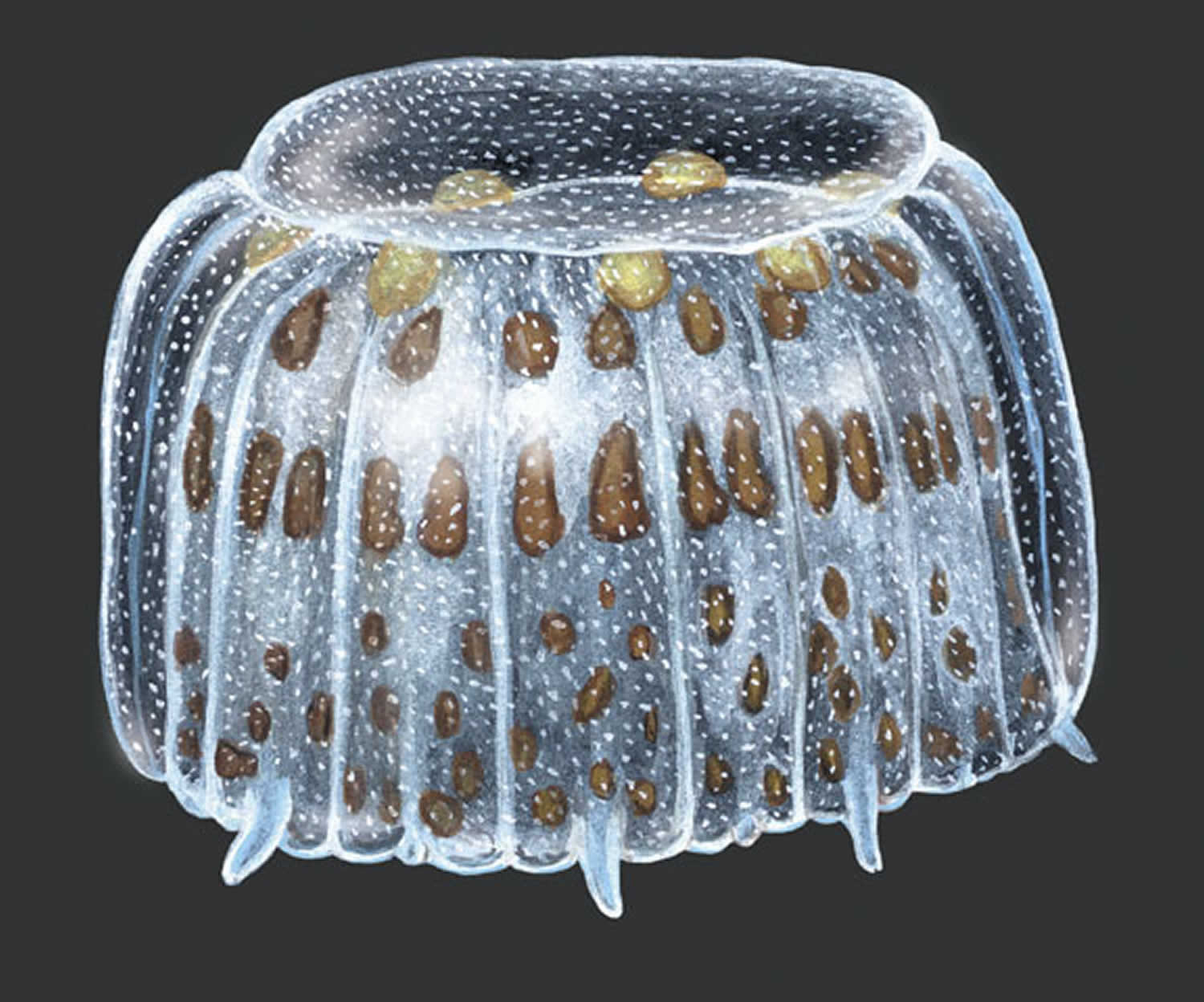Seabather’s eruption
Seabather’s eruption is a highly itchy, papular eruption that affects areas of your skin covered by a bathing suit (underneath the swimsuit), rather than exposed areas, after extended exposure to seawater. Seabather’s eruption is caused by stings from the stinging cells also called nematocysts of the larval forms of certain sea anemones and thimble jellyfishes (Linuche unguiculata) 1. Sea thimble jellyfishes are small tropical jellyfish that, even as adults, get no larger than about a centimeter in size. Cases have been reported in the Phillipines and have been attributed to Linuche aquila 2. Most cases of sea bather’s eruption occur during the summer as it seems to be dependant on water temperature. Most cases occur from March to August, but the incidence peaks in May and June. Seabather’s eruption affects swimmers, snorkelers, or divers soon after getting out of the water.
Seabather’s eruption has been called sea lice by some. Sea lice is actually due to immature larval forms of parasitic flatworms (schistosomes), penetrating the skin.
Seabather’s eruption was first described in 1949 as an itchy rash occurring after swimming off the eastern coast of Florida 3. It has now been reported to occur in many tropical and sub-tropical waters. In Florida it is called ‘Pica-Pica’, the Spanish for ‘Itchy-Itchy’.
Sea bather’s eruption is often misnamed ‘sea lice’, which are true crustacean parasites of fish. These flatworm larvae try to burrow into the swimmers skin (so they bite rather than sting) and are usually found on exposed skin (similar to sandfly bites). Sea bather’s rash can also look very similar to seaweed dermatitis, but no seaweed is found on the skin or in swimwear.
Figure 1. Seabather’s eruption
Figure 2. Thimble jellyfish
Seabather’s eruption causes
Seabather’s eruption is a hypersensitivity reaction to the larval form (planulae), of the thimble jellyfish, Linuche unguiculata 4. Seabather’s eruption on Long Island, New York, has also been reported to be caused by the larvae stage of the sea anemone, Edwardsiella lineata 5. This organism also has nematocysts. Various species of Cnidaria larvae in other waters can likely produce similar eruptions.
Seabather’s eruption typically occurs underneath the bathing garments, which are believed to trap the jellyfish larvae against the skin. Whether the discharge of venom by the trapped larvae plays an important role in the pathogenesis of the eruption remains uncertain. Factors that promote the discharge of venom by the larvae include wearing of bathing suits for prolonged periods following swimming, exposure to fresh water through showering, and mechanical stimulation.
The rash is caused by the body’s allergic reaction to the toxin injected into the skin by the tiny stinging cells or nematocysts of the larval jellyfish. These tiny larval forms (the size of a pin head) become trapped underneath bathing suits or in the hair of the bather. Each larva is equipped with a number of stinging cells, that can be triggered by simple mechanical pressure or by osmotic changes that occur with evaporation or when rinsing off with freshwater. The rash typically develops underneath the bathing costume, which is believed to trap the jellyfish larvae against the skin. As the swimmer gets out of the sea, water drains out of the bathing suit, trapping the larva between the suit and the skin. Pressure on the small jelly fish cause the stinging cells to discharge, releasing toxin into the skin. Wearing bathing suits for prolonged periods after swimming, showering in fresh water, and mechanical stimulation (rubbing with a towel) make the eruption worse.
Be aware that you can still be stung days or weeks later after washing and drying the infested clothing. The stinging cells are not actually alive and can persist until a particular physical or chemical reaction stimulates them to fire the stinger that contains the toxin.
The seasonal variation in the concentrations of thimble jellyfish larvae in endemic areas lead to the increased incidence of seabather’s eruption from May through August, with a peak in May and June.
Seabather’s eruption epidemiology
United States
The incidence of seabather’s eruption is seasonal; the highest incidence occurs from May through August. This coincides with the warm gulf streams running along the Atlantic coastline of Florida and the corresponding spawn of thimble jellyfish larvae, which results in the high seasonal concentration of Linuche planulae. In 1997, Kumar et al 6 reported the occurrence of seabather’s eruption in Palm Beach saltwater swimmers in May to be 16%.
International
Seabather’s eruption has been reported in Mexico and the Caribbean and along the coast of Brazil 7. Reports have occurred in the Phillipines 2. The true prevalence of seabather’s eruption along other international coastlines remains unknown.
Seabather’s eruption prevention
Other than staying out of the water, not much can be done to completely avoid the jellyfish’s sting if they are present in the water. People have tried various barrier creams to prevent the larvae from getting to the skin but creams do not provide a strong enough barrier to the stingers. Sometimes, a wet suit will limit the infestation to the edges of the garment. General experience indicates the infestation seems to occur near the surface of the water so snorkelers and swimmers seem to be the most vulnerable.
If you think have been exposed to the jellyfish larvae, the most effective preventive measure is to take off your bathing costume as soon as possible and rinse the body in seawater that doesn’t have the jelly fish. Pat-dry with a towel and change your clothes. Do not rub the affected areas with towels or hands as that could cause additional stinging. Caution: An immediate rinse with fresh water, vinegar or other solutions may actually cause additional stinging from larvae clinging to your skin or clothes.
Seabather’s eruption symptoms
A tingling sensation under the bathing suit (breasts, groin, cuffs of wetsuits) is often first noticed while still in the water. Over several hours it becomes an itch, which can last for several weeks (typically lasts 1-2 weeks). Itch is the most common symptom in patients with seabather’s eruption (98%). It is generally confined under the swimming costume and some patients (up to a fifth) complain of feeling slightly unwell, with temperatures and fatigue. Fever is observed in 18% of patients. Some children also develop tummy upsets. As one takes a freshwater shower, while still wearing the bathing suit, the itch gets worse. Itching can be quite severe and become painful. 40% of patients younger than 16 years report fever compared with 10% of adults.
Children more commonly than in adults demonstrate systemic symptoms, including fever, nausea, abdominal pain, and diarrhea 8. These symptoms may be mistaken for viral gastritis, possibly leading the patient to seek treatment in the emergency department.
The rash usually starts a couple of hours after swimming in the ocean. It consists of red bumps, which may become dense and run together in a mass. Each person may react differently to the stings depending on their sensitivity and previous exposure.
Seabather’s eruption complications
Because of the nature of the allergic hypersensitivity underlying the disease, patients are susceptible to recurrence upon reexposure. Reports have described exaggerated symptomatology in recurrent cases of seabather’s eruption, and, for such individuals, avoiding seawater on affected beaches during seasonal peaks is best.
Seabather’s eruption diagnosis
Diagnosis of seabather’s eruption is made based on the history of exposure and the physical examination. Laboratory studies and skin biopsy are unnecessary. Although only available for research purposes, Wong et al have demonstrated elevated serum levels of immunoglobulin G antibodies specific for thimble jellyfish (Linuche unguiculata) 9.
Physical examination
On physical examination, patients with seabather’s eruption typically display inflammatory papules in a distribution pattern that mimics the bathing suit. Lesions have been noted to occur in the axillae; in men with significant chest hair, they occur on the chest.
Relatively rare signs and symptoms of seabather’s eruption include the following:
- Nausea
- Headache
- Sore throat
- Cough
- Diarrhea
- Abdominal pain
Skin biopsy
A punch biopsy of involved skin may prove useful in narrowing the differential diagnosis when obtaining a reliable history of exposure is difficult. A skin biopsy demonstrates a predominant superficial and deep perivascular and interstitial infiltrate consisting of lymphocytes, eosinophils, and neutrophils. Generally, no epidermal changes are noted, and the dermal-epidermal junction is intact.
Seabather’s eruption treatment
Patients with seabather’s eruption require only symptomatic or supportive therapy. Once seabather’s eruption occurs and you have taken off your swimming costume and showered, an application of diluted vinegar or rubbing alcohol may neutralize any toxin left on the skin. An ice pack may help to relieve any pain. The most useful treatment is 1% hydrocortisone lotion applied 2-3 times a day for 1-2 weeks. Topical calamine lotion with 1% menthol may also be soothing. Nonsteroidal anti-inflamatory drugs (NSAIDs) such as ibuprofen and aspirin (but not in children) may also help to reduce pain and inflammation.
If the reaction is severe, the injured person may suffer from headache, fever, chills, weakness, vomiting, itchy eyes and burning on urination, and should be treated with oral prednisone (steroids).
The stinging cells may remain in the bathing suit even after it dries, so once a person has developed sea bather’s eruption, the clothing should undergo machine washing or be thoroughly rinsed in alcohol or vinegar, then be washed by hand with soap and water.
Antihistamines may also be of some benefit. Other treatments that have been suggested include remedies made with sodium bicarbonate, sugar, urine, olive oil, and meat tenderizer although some of these some may increase the release of toxin and aggravate the rash. Symptoms of malaise, tummy upsets and fever should be treated in the normal fashion.
Patients rarely demonstrate associated systemic symptomatology severe enough to require hospitalization. Even then, treatment is largely supportive and should include systemic corticosteroids.
Seabather’s eruption prognosis
Cutaneous eruptions clear in 2 weeks, with or without therapy. No deaths have been attributed to exposure to thimble jellyfish larvae.
- Segura-Puertas L, Ramos ME, Aramburo C, Heimer De La Cotera EP, Burnett JW. One Linuche mystery solved: all 3 stages of the coronate scyphomedusa Linuche unguiculata cause seabather’s eruption. J Am Acad Dermatol. 2001 Apr. 44 (4):624-8.[↩]
- Guevara BEK, Dayrit JF, Haddad V Jr. Seabather’s eruption caused by the thimble jellyfish (Linuche aquila) in the Philippines. Clin Exp Dermatol. 2017 Oct. 42 (7):808-810.[↩][↩]
- Seabather’s eruption. https://emedicine.medscape.com/article/1088160-overview[↩]
- Seabather’s eruption. https://dermnetnz.org/topics/sea-bathers-eruption[↩]
- Freudenthal AR, Joseph PR. Seabather’s eruption. N Engl J Med. 1993 Aug 19. 329(8):542-4.[↩]
- Kumar S, Hlady WG, Malecki JM. Risk factors for seabather’s eruption: a prospective cohort study. Public Health Rep. 1997 Jan-Feb. 112(1):59-62.[↩]
- Eyer-Silva WA, Pitombo FB, Silva GARD. Seabather’s eruption in Ipanema Beach, Rio de Janeiro, Brazil. Rev Soc Bras Med Trop. 2018 Jan-Feb. 51 (1):119.[↩]
- Quail MT. Warm water hazard: Sea lice and seabather’s eruption. Nursing. 2019 Jan. 49 (1):40-43.[↩]
- Wong DE, Meinking TL, Rosen LB, Taplin D, Hogan DJ, Burnett JW. Seabather’s eruption. Clinical, histologic, and immunologic features. J Am Acad Dermatol. 1994 Mar. 30(3):399-406.[↩]







